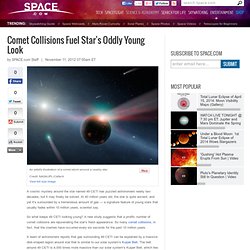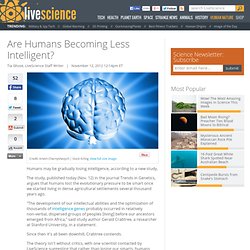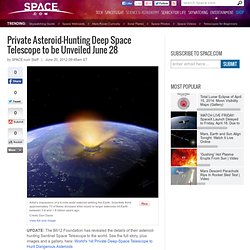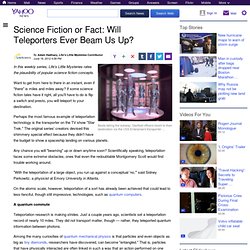

joe
Topological Matter in Optical Lattices. Comet Collisions Fuel Star's Oddly Young Look. A cosmic mystery around the star named 49 CETI has puzzled astronomers nearly two decades, but it may finally be solved.

At 40 million years old, the star is quite ancient, and yet it's surrounded by a tremendous amount of gas — a signature feature of young stars that usually fades within 10 million years, scientist say. So what keeps 49 CETI looking young?
Joem 4. Joem 3. Rare Particle Find May Cast Doubt on Popular Physics Theory. An extremely rare particle measurement from the world's largest atom smasher could cast doubt on a popular theory about the fundamental building blocks of the universe, including dark matter.

Physicists from the Large Hadron Collider (LHC) in Switzerland have measured a particular type of particle transformation for the first time, and found that it happens just about as often as predicted by the dominant theory of particle physics, called the Standard Model. The measurement is just preliminary — the researchers haven't collected enough data to be positive what they're seeing isn't just a random occurrence. Still, the fact that the initial observations correspond so well with the Standard Model predictions isn't a hopeful sign for what scientists call "new physics," such as new particles not predicted by the Standard Model. Rarest ever seen View gallery In this chart, the red dashed line represents the signal seen inside the Large Hadron Collider of B_ … Supersymmetric particles.
Jom #5. Can Digital Drugs Get You High? A-level Physics (Advancing Physics) A-level Physics (Advancing Physics) From Wikibooks, open books for an open world Welcome to the Wikibooks textbook on Physics, designed to contain everything you need to know for the OCR Physics B (Advancing Physics) specification[1].

All sorts of useful documents for this specification are available at . All units are assumed to be SI units, unless stated otherwise. Diagrams can be enlarged by clicking on them. Chapters are probably marked as 75% complete ( ) because they are complete, but may require some attention. Contents Subjects: Hidden categories: Navigation menu Personal tools. Are Humans Losing Their Smarts? Humans may be gradually losing intelligence, according to a new study.

The study, published today (Nov. 12) in the journal Trends in Genetics, argues that humans lost the evolutionary pressure to be smart once we started living in dense agricultural settlements several thousand years ago. "The development of our intellectual abilities and the optimization of thousands of intelligence genes probably occurred in relatively non-verbal, dispersed groups of peoples [living] before our ancestors emerged from Africa," said study author Gerald Crabtree, a researcher at Stanford University, in a statement. Since then it's all been downhill, Crabtree contends. Are Humans Becoming Less Intelligent? Humans may be gradually losing intelligence, according to a new study.

The study, published today (Nov. 12) in the journal Trends in Genetics, argues that humans lost the evolutionary pressure to be smart once we started living in dense agricultural settlements several thousand years ago. "The development of our intellectual abilities and the optimization of thousands of intelligence genes probably occurred in relatively non-verbal, dispersed groups of peoples [living] before our ancestors emerged from Africa," said study author Gerald Crabtree, a researcher at Stanford University, in a statement.
Since then it's all been downhill, Crabtree contends. The theory isn't without critics, with one scientist contacted by LiveScience suggesting that rather than losing our smarts, humans have just diversified them with various types of intelligence today. Life or death situations. Supersonic Flying Wing Nabs $100,000 from NASA. An aircraft that resembles a four-point ninja star could go into supersonic mode by simply turning 90 degrees in midair.

The unusual "flying wing" concept has won $100,000 in NASA funding to trying becoming a reality for future passenger jet travel. Sky. Private Deep Space Asteroid Telescope Mission to be Unveiled June 28. UPDATE: The B612 Foundation has revealed the details of their asteroid-hunting Sentinel Space Telescope to the world.

See the full story, plus images and a gallery, here: World's 1st Private Deep-Space Telescope to Hunt Dangerous Asteroids A group of scientists will unveil an audacious plan for the first privately funded deep space telescope next week - a mission that aims to map the inner solar system for potentially dangerous asteroids. On June 28, members of the B612 Foundation will discuss plans to build, launch and operate the Sentinel Space Telescope Mission during a press conference at the Morrison Planetarium at the California Academy of Sciences in San Francisco. Misbehaving Particles Poke Holes in Reigning Physics Theory. The reigning theory of particle physics may be flawed, according to new evidence that a subatomic particle decays in a certain way more often than it should, scientists announced.

This theory, called the Standard Model, is the best handbook scientists have to describe the tiny bits of matter that make up the universe. But many physicists suspect the Standard Model has some holes in it, and findings like this may point to where those holes are hiding. Inside the BaBar experiment at the SLAC National Accelerator Laboratory in Menlo Park, Calif., researchers observe collisions between electrons and their antimatter partners, positrons (scientists think all matter particles have antimatter counterparts with equal mass but opposite charge).
When these particles collide, they explode into energy that converts into new particles. Science Fiction or Fact: Will Teleporters Ever Beam Us Up? In this weekly series, Life's Little Mysteries rates the plausibility of popular science fiction concepts.

Want to get from here to there in an instant, even if "there" is miles and miles away? If some science fiction tales have it right, all you'll have to do is flip a switch and presto, you will teleport to your destination. Perhaps the most famous example of teleportation technology is the transporter on the TV show "Star Trek. " The original series' creators devised this shimmery special effect because they didn't have the budget to show a spaceship landing on various planets.
Icy Antarctica Once Ringed With Carpet of Lush Flora. The few plants that live in Antarctica today are hardy hangers-on, growing just a few weeks out of the year and surviving poor soil, lack of rain and very little sunlight.

But long ago, some parts of Antarctica were almost lush. New research finds that between about 15 million and 20 million years ago, plant life thrived on the coasts of the southernmost continent. Ancient pollen samples suggest that the landscape was a bit like today's Chilean Andes: grassy tundra dotted with small trees. This vegetated period peaked during the middle Miocene, when atmospheric carbon dioxide levels were around 400 to 600 parts per million. (Today, driven by fossil fuel use, atmospheric carbon dioxide has climbed to 393 parts per million.)
As a result, global temperatures warmed. NASA's Juno Mission to Probe Jupiter's Biggest Secrets. ANCHORAGE, Alaska — A NASA probe that is traveling through space on its way to Jupiter is expected to help astronomers unlock mysteries about the largest planet in our solar system when it arrives there in 2016.
NASA's Juno mission was launched in August 2011 to study how Jupiter formed and evolved. After a five-year journey, the spacecraft is expected to arrive at the gas giant planet in August 2016. Franken-Physics: Atoms Split in Two & Put Back Together. Physicists have just upped their ante: Not only have they split atoms but, even trickier, they've put them back together. Their secret? Quantum physics. SLOOH SpaceCamera - Live Event.
Interstellar Gas Molecule Mystery Revealed. Scientists have untangled the structure of an elusive space molecule that may help astronomers better understand the vast clouds of interstellar gas across our Milky Way galaxy. Unable to directly detect the coldest clouds of the most plentiful molecule in the universe, astronomers must rely on its interactions to find it. The search should become easier with an improved understanding of the compound H2-CO, frequently used as a tracer chemical. After obtaining a very accurate reading of the most plentiful variety of this compound, an international team of scientists was able to map its distribution across space.
Why We Must Flee the Planet: The Geometry of Earth is All Wrong. Stephen Hawking is best known for thinking about time, space, and those teratoid trash mashers known as black holes. Near-Space Tourism Balloon Runs Test Launch. Giant Tropical Lake Found on Saturn Moon Titan. Pat's Likes – Page 1. Pat's Likes – Page 7. Secrets of the first practical artificial leaf.
A detailed description of development of the first practical artificial leaf -- a milestone in the drive for sustainable energy that mimics the process, photosynthesis, that green plants use to convert water and sunlight into energy -- appears in the ACS journal Accounts of Chemical Research. The article notes that unlike earlier devices, which used costly ingredients, the new device is made from inexpensive materials and employs low-cost engineering and manufacturing processes. Daniel G. Vertical Farms Sprout into Reality. Holograms That You Can Touch and Feel. Youtube Documentaries. The 13 Most Important Numbers in the Universe - James D. Stein's Cosmic Numbers. Encyclopedia of astrophysics. Engineering: Free Courses. Free Physics Books. 7 Man-Made Substances that Laugh in the Face of Physics. The universe is full of weird substances like liquid metal and whatever preservative keeps Larry King alive.
Team Evolution pearled one of your most unique items: Was humanity born in the mother of all plagues? The Nasa 'space drink' hat can rub out sun spots: Fruit juice developed to protect astronauts reduces wrinkles and reverses the telltale signs of ageing in four months. The Discovery of Complex Organic Matter in the Universe. Was humanity born in the mother of all plagues? Why Humans Prevailed.
NEW YORK — One hundred thousand years ago, several humanlike species walked the Earth. Graphene. High-quality graphene is strong, light, nearly transparent and an excellent conductor of heat and electricity. Its interactions with other materials and with light and its inherently two-dimensional nature produce unique properties, such as the bipolar transistor effect, ballistic transport of charges and large quantum oscillations. Fullerene. NanotubeTV Episode One: Introduction to nanotechnology. Tesla's Big Mistake? The Scale of the Universe. Physics Institutions and Journals by their Subject of Research. Superfluid and superconductor discovered in star's core. The Extrasolar Planets Encyclopaedia. FLASH Laser Leads to Discovery of New State of Matter. Europe Guide : Maps of Europe by language, religion, population density, hair & eye color, etc.
Free Online Course Materials. 'Tendex' lines help visualise black holes - space - 13 April 2011. Turning windows into powerplants. Physics - spotlighting exceptional research. Gravity Probe B: Testing Einstein's Universe. Inside the World's Largest Fusion Reactor. Navy Test-Fires Missiles from Robot Boats. Liquid Magnet: Stirred, not Shaken. Spooky Quantum Entanglement Gets Extra 'Twist' How a Real-Life Astrophysicist Found Superman's Planet Krypton: The Inside Story. Lectures. NEO Earth Close Approaches. Near-Earth Asteroid Loses Its Magnetic Mojo. The Fermilab Holometer. Weird things » exploring science, technology, the strange and the unknown.
Tasmanian Devil's Sneaky, Contagious Cancer Evolves. China’s Mystery Space Plane Stirs Up Questions. Mystery of Angkor Wat Temple's Huge Stones Solved. Science & Technology: Grad-Shafranov Reconstruction of Magnetic Flux Ropes in the Near-Earth Space. The Self-Sustaining, Solar-Powered Emergency Shelter: We’re Going to Need It - Environment. Habitable exoplanet confirmed? Warm and wet, scientists say. How Quantum Effects Could Create Black Stars, Not Holes. NASA's WISE mission finds first Trojan asteroid sharing Earth's orbit. Hydrogen Fuel Tech Gets Boost from Low-Cost, Efficient Catalyst. PhysOrg.com - Science News, Technology, Physics, Nanotechnology, Space Science, Earth Science, Medicine. Touchn2btouched. Space Settlement - National Space Society. Interplanetary Transport Network. Japanese breakthrough will make wind power cheaper than nuclear.
Levitation trick Video. Relativity of Electric and Magnetic Fields. Inside NASA's New Spaceship for Asteroid Missions. New High-Tech Material Fixes Itself. New ultra-battery is the most powerful non-nuclear energy storage ever. Microscopic 'Bullets' Put New Armor to the Test. Station Astronaut Drives Robot on Earth via 'Interplanetary Internet' Vesta Up Close: What the Dawn Probe Revealed. Even Scientists Unwittingly See Purpose in Nature. Infographic: Earth's Atmosphere Layers.
Oldest, Farthest Star Explosions Discovered in Distant Universe. Near-Earth Asteroid Loses Its Magnetic Mojo. Weird-Looking, Meat-Eating Sponge Found In Deep Sea. Jet-Size Pterosaurs Took Off from Prehistoric Runways. Flying Fish Evolved to Escape Prehistoric Predators. Soccer-Playing Robot's Creators Release Software for Free.
Getting started.